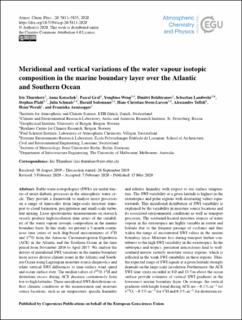| dc.contributor.author | Thurnherr, Iris | |
| dc.contributor.author | Kozachek, Anna V. | |
| dc.contributor.author | Graf, Pascal | |
| dc.contributor.author | Weng, Yongbiao | |
| dc.contributor.author | Bolshiyanov, Dimitri Yu. | |
| dc.contributor.author | Landwehr, Sebastian | |
| dc.contributor.author | Pfahl, Stephan | |
| dc.contributor.author | Schmale, Julia | |
| dc.contributor.author | Sodemann, Harald | |
| dc.contributor.author | Steen-Larsen, Hans Christian | |
| dc.contributor.author | Toffoli, Alessandro | |
| dc.contributor.author | Wernli, Heini | |
| dc.contributor.author | Aemisegger, Franziska | |
| dc.date.accessioned | 2021-08-13T07:20:58Z | |
| dc.date.available | 2021-08-13T07:20:58Z | |
| dc.date.created | 2021-01-29T12:53:30Z | |
| dc.date.issued | 2020 | |
| dc.identifier.issn | 1680-7316 | |
| dc.identifier.uri | https://hdl.handle.net/11250/2767695 | |
| dc.description.abstract | Stable water isotopologues (SWIs) are useful tracers of moist diabatic processes in the atmospheric water cycle. They provide a framework to analyse moist processes on a range of timescales from large-scale moisture transport to cloud formation, precipitation and small-scale turbulent mixing. Laser spectrometric measurements on research vessels produce high-resolution time series of the variability of the water vapour isotopic composition in the marine boundary layer. In this study, we present a 5-month continuous time series of such ship-based measurements of δ2H and δ18O from the Antarctic Circumnavigation Expedition (ACE) in the Atlantic and the Southern Ocean in the time period from November 2016 to April 2017. We analyse the drivers of meridional SWI variations in the marine boundary layer across diverse climate zones in the Atlantic and Southern Ocean using Lagrangian moisture source diagnostics and relate vertical SWI differences to near-surface wind speed and ocean surface state. The median values of δ18O, δ2H and deuterium excess during ACE decrease continuously from low to high latitudes. These meridional SWI distributions reflect climatic conditions at the measurement and moisture source locations, such as air temperature, specific humidity and relative humidity with respect to sea surface temperature. The SWI variability at a given latitude is highest in the extratropics and polar regions with decreasing values equatorwards. This meridional distribution of SWI variability is explained by the variability in moisture source locations and its associated environmental conditions as well as transport processes. The westward-located moisture sources of water vapour in the extratropics are highly variable in extent and latitude due to the frequent passage of cyclones and thus widen the range of encountered SWI values in the marine boundary layer. Moisture loss during transport further contributes to the high SWI variability in the extratropics. In the subtropics and tropics, persistent anticyclones lead to well-confined narrow easterly moisture source regions, which is reflected in the weak SWI variability in these regions. Thus, the expected range of SWI signals at a given latitude strongly depends on the large-scale circulation. Furthermore, the ACE SWI time series recorded at 8.0 and 13.5 m above the ocean surface provide estimates of vertical SWI gradients in the lowermost marine boundary layer. On average, the vertical gradients with height found during ACE are −0.1‰m−1 for δ18O, −0.5‰m−1 for δ2H and 0.3 ‰ m−1 for deuterium excess. Careful calibration and post-processing of the SWI data and a detailed uncertainty analysis provide a solid basis for the presented gradients. Using sea spray concentrations and sea state conditions, we show that the vertical SWI gradients are particularly large during high wind speed conditions with increased contribution of sea spray evaporation or during low wind speed conditions due to weak vertical turbulent mixing. Although further SWI measurements at a higher vertical resolution are required to validate these findings, the simultaneous SWI measurements at several heights during ACE show the potential of SWIs as tracers for vertical mixing and sea spray evaporation in the lowermost marine boundary layer. | en_US |
| dc.language.iso | eng | en_US |
| dc.publisher | Copernicus Publications | en_US |
| dc.rights | Navngivelse 4.0 Internasjonal | * |
| dc.rights.uri | http://creativecommons.org/licenses/by/4.0/deed.no | * |
| dc.title | Meridional and vertical variations of the water vapour isotopic composition in the marine boundary layer over the Atlantic and Southern Ocean | en_US |
| dc.type | Journal article | en_US |
| dc.type | Peer reviewed | en_US |
| dc.description.version | publishedVersion | en_US |
| dc.rights.holder | Copyright Author(s) 2020. | en_US |
| dc.source.articlenumber | 5811-5835 | en_US |
| cristin.ispublished | true | |
| cristin.fulltext | original | |
| cristin.fulltext | original | |
| cristin.qualitycode | 2 | |
| dc.identifier.doi | https://acp.copernicus.org/articles/20/5811/2020/ | |
| dc.identifier.cristin | 1882387 | |
| dc.source.journal | Atmospheric Chemistry and Physics | en_US |
| dc.identifier.citation | Atmospheric Chemistry and Physics. 2020, 20, 5811-5835. | |
| dc.source.volume | 20 | en_US |

